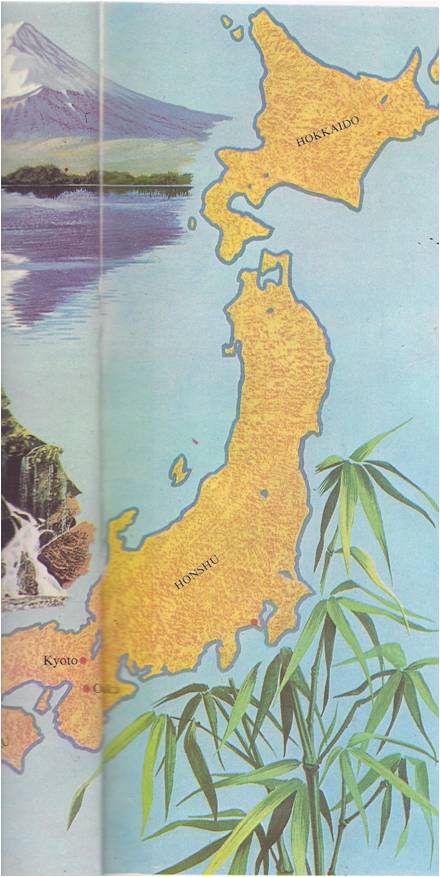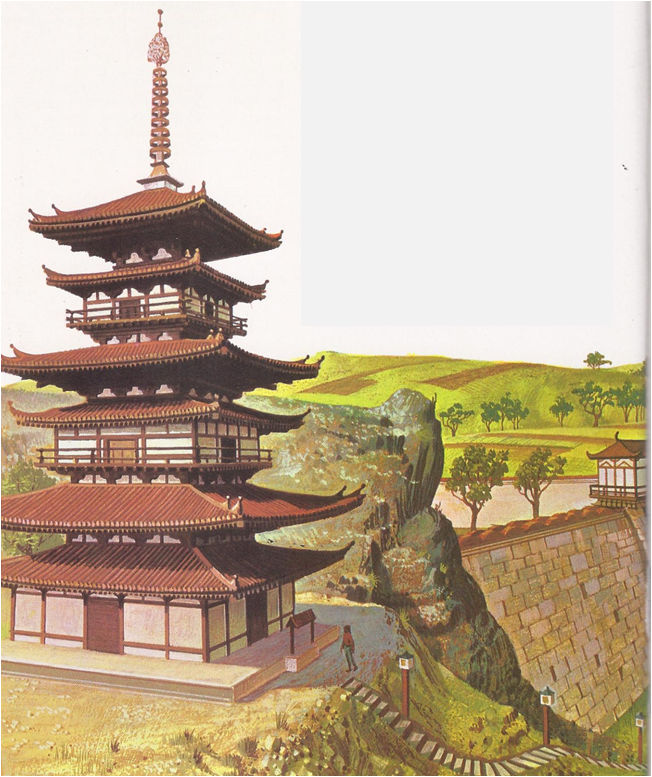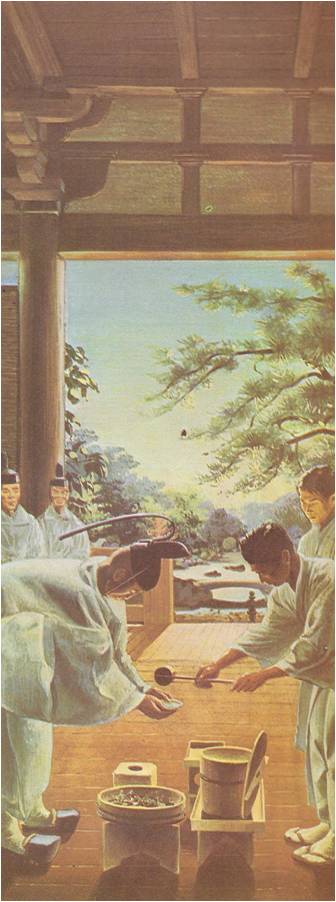DRAWING ON nature for inspiration, the Japanese invented a number of gods and goddesses. They took it for granted that their islands and their ancestors had been created by gods. Many different stories were told about how these things had happened.
The official account of how Japan got started was finally laid down in 720, in a book called Nikon Shoki, or The History of Japan. This book, written on the orders of the emperor, was a hodge-podge of myths and family trees, with a little recent history thrown in. Its authors were trying to please their imperial master. T o give Japan a long, respectable past like China’s, they claimed that it had been founded nearly fourteen hundred years before, by a god named Jimmu. They traced the descent of the emperor all the way back to this god.

Nihon Shoki was not a very reliable source of facts. Almost to the present, most Japanese people have believed everything it said. For this reason it is the most important book in their history.
According to its authors, everything began with the god Izanagi and the goddess Izanami, who lived in heaven. They came down to the earth, where Izanami gave birth to the Japanese islands. Then the couple had other children, all gods and goddesses. Izanami died while bearing the fire god and sank down to the lower world. There, Izanagi visited her. Izanami’s flesh had begun to rot; rather than let Izanagi see her in such a state, she sent him away. In his grief, Izanagi shed his garments, each of which turned into a god or goddess. Then, to purify himself after his meeting with Izanami, he washed. As he did, every part of his body became a god or a goddess.
MIRROR, SWORD AND JEWEL
Among these last were a sun goddess called Amaterasu and a mischievous god named Susa-no-o. Rising together to the Plain of High Heaven, Amaterasu and Susa-no-o produced still another group of gods and goddesses. Susa-no-o was not a good husband. He trampled down the rice plants in Amaterasu’s fields and dirtied up her house. The sun goddess was so upset that she hid in a cave, making the whole world go dark. Soon, however, she was lured out again by the music and laughter of the other gods and goddesses, who were dancing in the darkness. When she told them about her troubles, they took her side and banished Susa-no-o from heaven. He went down to the earth and married a Japanese woman, to become the founder of a family of human rulers on the big Japanese island, Honshu.
Sometime later, a grandson of Amaterasu and Susa-no-o, called Ninigi, came down to the island of Kyushu. With him he brought his grandmother’s bronze mirror, his grandfather’s iron sword, and a curved jewel. On Kyushu, Ninigi founded a dynasty of gods. The dynasty was called the sun line in honour of Amaterasu.

One of Ninigi’s great-grandsons was named Jimmu, or “Divine Warrior.” Jimmu raised an army of gods and sailed up the Inland Sea to the plain at the other end, on Honshu. There, in 660 B.C., he conquered the local gods and established the Japanese state in the part of the Nara Plain called Yamato. Jimmu’s descendants have ruled Japan ever since.
The last part of this tale may have been based on things that really happened. A human general probably did bring an army from Kyushu, conquer the people of the Nara Plain and set himself up as their ruler. Very likely the general was the leader of the tomb culture people, so the chances are that the Japanese state was actually founded in the third century. It is also possible that the conquering general founded the imperial dynasty that has since reigned over Japan. The objects which Jimmu’s great-grandfather Ninigi was supposed to have brought down from heaven — the bronze mirror, iron sword and curved jewel — are still the symbols of imperial authority in Japan.
Almost nothing is known about the Japanese state in its early years. About the year 400, however, Korean scribes arrived at the court of Yamato. From then on, they and the scribes who came after them kept records — not in Japanese, which people spoke but did not yet write, but in the great literary language of the East, Chinese. From these records it seems that the Japanese empire took in most of Honshu, plus Shikoku, Kyushu and a part of South Korea across the sea. The people were grouped together in clans headed by aristocrats. These aristocrats did not always obey the emperors, for they thought of them as being simply clan leaders like themselves.
THE WAY OF THE GODS
Slowly, the emperors gained power. They did this by turning their subjects’ love of nature to their own advantage. To the nature worship practiced throughout Japan, they added a state religion with themselves at its head. By stressing the idea that the emperors were descended from the gods, the religion encouraged the people to look up to them as fathers and protectors.
This religion came to be called Shinto, from two Chinese words meaning the “Way of the Gods.” Shinto rites were very simple. All a worshiper did, on coming to a shrine, was clap his hands, bow and leave a small offering, such as a rice cake, a cup of rice wine, or a strip of cloth. It was not so easy for the emperors. As heads of the religion and objects of worship, too, they had to spend hour after hour at tiresome ceremonies.

Meanwhile, the Japanese were learning more about the civilization of their great neighbour to the west, China. Their teachers were mostly Koreans. Many Koreans who came to Japan were given titles in the Japanese aristocracy, particularly those who brought followers, servants and slaves with them. Their superior knowledge made them very welcome.
For a long time the Japanese were so busy finding out how to make use of the unfamiliar ideas and skills that they hardly gave a thought to where they had come from. The first thing they deliberately borrowed from China was Buddhism. After a fifty-year struggle between supporters of Buddhism and diehard Shintoists, the Buddhists won out. Buddhism did not replace the worship of rare, gods and the emperors. Instead, it began to take over Shintoism, without changing it.
In 587, the emperor himself became a Buddhist. As the century ended, a firm believer in Buddhism became the ruler of Japan, governing for his aunt, the empress, as her regent. His name was Prince Shotoku.





